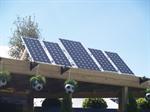What is Solar Radiation
 Understanding Solar Radiation
Understanding Solar Radiation
Approximately 99.8% of solar radiation is input into the earth. This energy may be absorbed, reflected and/or transmitted by the object struck. Every object or surface absorbs or reflects heat in diverse ways: lighter colours reflect more heat and darker colours absorb more heat.
As the solar radiation passes through the atmosphere, part of it is absorbed by the atmospheric gases, such as the ozone, water vapour and carbon dioxide (CO2). Another part of it is reflected back into the universe by the clouds. Some of the heat is dispersed in many directions by the reflection caused by tiny particles present in the air (e.g. gas molecules in the atmosphere, dust, etc).
In terms of spectral density (wavelengths), these rays start off as short wave radiations, also known as UV (ultraviolet rays), which, after passing through the atmosphere, they are absorbed by the earth’s surface causing a heated radiation that warms up the air, which are long wave radiations also known as IR (infrared rays).
Different parts of the earth receive different intensity of radiation due to the earth’s spherical shape. One specific part of the surface of the earth receives solar radiation at a ‘right angle’ (90o), which is when the sun is at its closest point to the object; when the sun is at this angle (above head) it is also referred to as ‘zenith’. When the sun is at its longest distance with the point or object, then it is said that the sun is in the ‘horizon’. At night there is no more solar radiation coming in, however, the outgoing radiation continues, which means there is a loss of energy from the earth back into space rather than the gain of energy that occurs during the day. In regards to day/night radiation as well as the position of the sun in relation to the earth, we can say that in equatorial regions there is a net gain of energy from radiation, whereas in the Polar Regions there is a net loss of energy from radiation. However, because the universe is always searching for balance, the excess energy or heat (warm air) in the equator is transferred and replaced by cool air through a process called ‘advection’. The temperature in this area cools down, while the temperature in the Polar Regions warm up.
The effect of the solar radiation that is absorbed will undoubtedly depend on the depth the heat travels through the substance or surface it is hitting, as well as the ‘heat capacity’ (i.e. the amount of heat required to change a mass unit of a substance by 1oC) each particular substance has. In other words, if the heat capacity (or specific heat) of a substance is low, then that means there is less energy required to raise the temperature of one unit of mass. For example: Sand is a poor heat conductor with low specific heat, therefore, it will receive some solar radiation, however, this will vary from object to object because darker sand will absorb more heat than light-coloured sand. Another example can be explained with snow, which is capable of lasting longer periods of sunny weather due to the fact that it has low absorption rate of solar radiation.
Want to Learn More?
Use our FREE COURSE COUNSELLING SERVICE
connect with one of our horticulturists and get professional advice
on books, courses and working in horticulture click and submit the form
or
Check out online bookstore for dozens of titles written by our principal and staff:
www.acsbookshop.com
You may also be interested in....